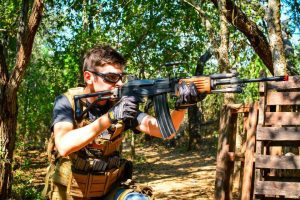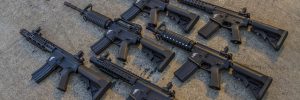April 9, 2018
What’s up guys, it’s Carl, and today I’m going to bore you into sleep by methodically explaining the virtues, fulfillment, and pulse pounding adrenaline that comes from… pretending to be a bush for 3 hours while you wait for an enemy patrol to walk into the kill zone.
BUCKLE UP. Today we’re talking ambushes.
Standard issue Carl disclaimer – this is all stuff I’ve learned in-game through years of being a BB dork and there are a million different ways to set this kinda stuff up, so don’t screech at me or whatever. Additionally, this is probably going to be aimed specifically at field type longer milsim games where you can afford to lie in wait and still feel like you’re getting your money’s worth. That being said, let’s jump into my top 3 tips on how to execute an effective airsoft ambush.
1) Selecting your kill zone. A smart squad is going to analyze the terrain features and select an area that ideally maximizes the available amount of cover, concealment and firing lanes to your target, and minimizes those same three things for the poor goobers caught in your trap. It’s a bit hard to illustrate this one without literally being able to walk through a field and show you what to look for, but sit down and let ol’ uncle carl spin ye a tale of BB glory from days past.
One of the most effective ambushes I’ve taken part in was at a very early MSW game in north eastern Washington in the mountains surrounding a small town called Leavenworth. For this particular event, our forces were staggeringly outnumbered, which necessitated our need to utilize tactics that would allow small squad sized elements to punch upwards at much larger forces without sustaining much loss. Obviously, getting into an open slug-fight wasn’t exactly what we wanted.
Enter the ambush – to level the playing field, we intentionally chose a dirt intersection with a route that fed directly out of the NATO patrol base. The road itself wasn’t very wide and had steep slopes and thick woods to either side of it, thereby limiting the amount of enemy players we’d conceivably had to deal with at once as they maneuvered down the road in a column. Steep slopes with loose dirt covered in taller grass and foliage rose from either side of this trail, creating both effective concealment from the enemy patrol, and a vertical advantage for us to fire down into that chokepoint intersection we designated as the kill zone itself.
In our case, the slope that the main ambush was launched from, combined with the leafy suits and local foliage to break up our shape, concealed our positions while giving use excellent eyes on the target as they approached our kill zone. The steep slope also made an enemy counterattack fairly unlikely, as breaking an ambush by fighting up hill is generally going to be very difficult.
The main idea here is that with a few simple conscious choices about where we were going to fight, we created a situation where the enemy’s superior numbers didn’t mean a whole lot, and a 6 or 7 man element killed the majority of a 40 man platoon before we ran away. However, none of this much matters much if you’ve got your squad arrayed in a nonsensical order, and that brings us to our next point – the physical makeup of your ambushing forces.
2) Once you’ve identified a piece of terrain as being favorable to your dudes to fight on, you then need to think about how you’re going to initiate contact, and from where.
Unfortunately we still have a ways to go when it comes to airsoft versions of antipersonnel mines, but one of the most brutal real military ambush tactics I can think of involves using machine gun and rifle fire to force the enemy into pre-selected very obvious cover, and once you’ve done that, you’d then detonate claymores placed in the trees and angled downwards into said cover to probably pretty devastating results. We can however, use that same type of manipulation of enemy forces for airsoft ambushes.
As ambushes are generally going to be kinda complex maneuvers that take coordination to pull off, you want to give your squad as many advantages in the first few seconds of the fight as possible. This particular ambush was actually initiated from a separate position across the road you can see in these photos, by a squadmate with a blankfire gun. As you can imagine, blank guns are really loud, so the idea here was that once the enemy players were allowed into this intersection, the blank gun would open up and draw their attention, forcing them into cover on the downslope of our hill.
All according to plan. Once the blank gun went off, they reacted exactly as we predicted they would, making them easy to kill and overrun by the 5 of us lying in wait.
There are a ton of different ways to set up your ambush, so i’m hesitant to talk about different types of specific formations because every squad and every piece of terrain is inherently going to be different, but perhaps more importantly than your plan itself is going to be your ability to rapidly adapt once the plan is executed.
3) Point number 3 – We’ve probably all heard the addage about no plan surviving first contact with the enemy, and that’s especially true here, but what can make or break a successful ambush is going to be your ability to pair what you expect to happen with what actually happens. If you’re a squad leader that’s ostensibly planning this nefarious trap, you need to be prepared to accept that it might not go exactly how you envision it – and that’s okay as long as you’re running multiple scenarios in the back of your head that’ll help you navigate those possibilities.
For example – we didn’t expect that the enemy in the ambush scenario above would attempt that flanking maneuver i mentioned, but we did still have two guns out in the woods on our hard right flank just in case they tried to get cute. In the event they were able to counter our ambush straight up the middle, our plan was to execute a series of bounds along that ridgeline and ultimately reset further down the road, and bait them into another ambush later.
Obviously they would have been more on-edge after that first hit, but there’s not a whole lot more demoralizing in airsoft than being caught off guard multiple times in a row. Even if you’re only nailing one or two guys at a time and then running away, it’s likely going to slow that column’s progress down to a crawl, which is insanely useful if you find yourself needing to execute a delaying action of some kind. There are tons of different ways to react to evolving situations, and again, a successful ambush can be an awesome psychological tool on the field, but it’s not worth much if you over-commit and get your team killed. Know when to press the attack, know when to call it off and get the hell out of dodge, and have a few pre-designated reaction plans that you’re squad is aware of beforehand, and you’ll be that much more likely to succeed.






